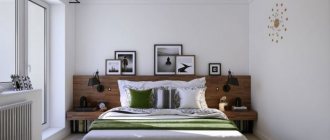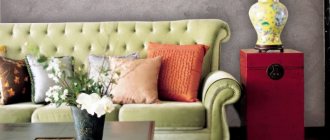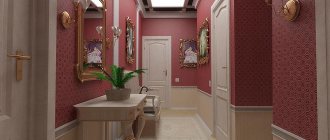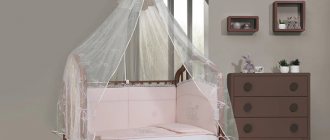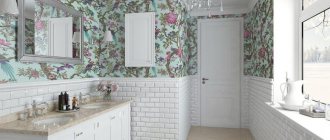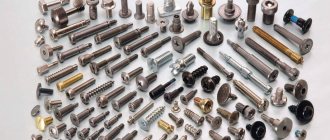Paint roller: how to choose a tool to implement a design idea
It is impossible to imagine a renovation without a paint roller when it comes to painting walls. Thanks to the variety of products in the store, choosing such a tool is easier. Meeting the needs of the buyer, a roller for applying an even layer of paint or creating a ribbed surface is considered an indispensable assistant.
How to choose by size
The main part of the device is a cylinder of different types:
- mini - having a diameter of 3–9 cm and a length of up to 15 cm. A tool with such a cylinder is used for painting surfaces with a small area;
- midi - practical medium-sized rollers. The diameter of the cylinder is 9 cm and the length is up to 20 cm. This is a type for finishing the interior surface of a house;
- maxi - used for exterior decoration of the house. The diameter of such a cylinder is 8 cm, length - 30 cm.
The size of the tool is selected in accordance with the area of the surface to be painted. For small jobs they use mini, and for large ones – midi and maxi.
Sometimes it seems that using large rollers to decorate the walls of rooms is better because they are large. But, during interior work, the base becomes heavy due to absorption, and the paint splashes or leaks. Another thing is painting the facade of a house: in the fresh air the coating dries faster, so speed plays a decisive role. For such work, tools with a maxi-size cylinder are used.
How to determine the length of the pile
The quality of the work performed depends on the correctly chosen length of the fur coat pile. Depending on the structure of the surface to be painted, rollers with different pile lengths are used.
- Up to 5 mm. — for painting smooth surfaces (mainly varnishing).
- 5–10 mm. - for painting ceilings and putty walls.
- 5–20 mm. Mainly used for painting concrete surfaces, unsanded wood or rough plaster.
- 20–30 mm. Coats with a long pile length are used to paint brick, concrete surfaces, walls with relief plaster, strong porosity and roughness.
Smooth, smooth walls do not require much effort to paint; a short pile will be enough. Another thing is a surface with many irregularities and roughness; to finish them, it is advisable to choose a roller with long pile. The variety of combinations of options for these components makes it possible to choose the appropriate tool for use in painting work.
Roller device
A roller for painting walls is a simple structure consisting of three parts:
- through cylinder made of wood, aluminum or plastic;
- absorbent coat;
- a handle consisting of a handle for holding the roller in the hand and a rod on which the cylinder is attached.
When an instrument is dipped in paint, the coat absorbs it over its entire surface. During operation, the cylinder rotates on a rod, ensuring uniform rolling of paint across the walls. Painting with a roller is a pleasure because it is almost effortless and does not require special skills. Thanks to the features of its device, this tool allows you to work quickly and save paint.
Lever
The length of the roller handle is usually from 30 to 50 cm. If it is necessary to lengthen the handle, for example, to paint the top of a high wall or ceiling, a special telescopic rod is used. It can be made of aluminum, plastic-coated metal, or fiberglass.
According to their design, handles are divided into two types:
- clasp;
- double-armed.
The clasp handle is, in fact, a curved metal rod on which an attachment is attached - a cylinder with a fur coat. A special coupling or pin is used to secure the nozzle.
USEFUL INFORMATION: Budget finishing: we use foam ceiling tiles
The double-arm handle is a fork that holds the nozzle on both sides.
Attaching the nozzle
Depending on the method of attaching the nozzle, the rollers are:
- detachable;
- hard.
The detachable roller allows the use of replaceable attachments. This is very convenient, because under one handle you can select attachments with different coats and change them as needed.
The rigid roller is a one-piece structure. After the coat wears out, such a tool will have to be thrown away entirely, since the handle and the nozzle are inseparable from each other.
Components of the roller
The tool has two components: the machine and the main working surface of the cylinder - the coat. The machine consists of a handle and a yoke.
Varieties of handle
The handle has a shape that is convenient for use; it can be made of wood or plastic. There are no specific standards for handles. When choosing a tool, you need to take into account the combination of size and weight: the handle should be comfortably grasped by the hand, and the fur coat should not outweigh the handle, otherwise it will be difficult to work.
Attaching the nozzle
The cylinder has three types of fastening.
- Rigid mount. Such a tool cannot be disassembled; after the coat wears out, the roller becomes unusable.
- The presence of a coupling. If necessary, the fur coat is replaced with a new one.
- Frame system. This type involves repeated use of the tool without a core.
Rollers with a specific fastening design are selected based on customer preferences.
Types of materials
A variety of materials makes it possible to choose the appropriate tool for a specific type of work. There are many types of fur coats:
- foam;
- fur;
- velor
- thread;
- polyamide;
- polyacrylic;
- polyester.
Each type has certain properties and, accordingly, a price.
A fur coat paints evenly, does not leave bubbles, it absorbs a small amount of paint, which is why there is almost no splashing. The only negative is that fibers may separate and remain on the surface to be painted.
If there are a lot of cracks that need to be filled with paint, it is advisable to choose a tool with longer bristles. A roller with a velor coat has the same qualities as a fur coat, but does not leave lint. The painted surface remains perfectly smooth.
Polyamide material is easy to clean after use. Thanks to its resistance to aggressive environments, the fur coat does not deteriorate, easily absorbs and releases any type of paint (even those containing water or synthetic solvents). Polyacrylic is considered a lower quality analogue of polyamide, but paints just as well. However, if different types of paint are applied with a polyamide coat, then only water-based ones are recommended for a polyacrylic coat.
The simplest painting tool that can be found in hardware stores is a foam rubber one. It copes well with smooth surfaces, but it is difficult to paint over uneven surfaces. It has a low cost, so if it is purchased only for one time, the option is quite suitable.
Using a roller with a thread coat works quite quickly. Thanks to its relief, it leaves beautiful patterns on the wall.
Roller selection
The roller is a cylindrical roller rotating around an axis, which is fixed to the handle. A special material is wound onto the cylinder, which is removable. Rollers of different sizes and with different materials can be attached to one handle-holder - woolen fabric, polymer material, artificial or natural fur.
Step 3: Assess the condition of the wall
Aside from properly preparing the wall, this is probably the most important step you can take to make your life easier during this project. In general, the newer the home, the less critical this step is, but it's always a good idea to give the site a thorough inspection before you begin.
Painting walls with a fabric roller: color selection
This is the point where you really want to poke and prod anything that looks even remotely weird and make sure it's in a paintable condition. This was brought up earlier, and while you can do a good job with cheap brushes and roller covers, you can do a better job with good high-end ones. To paraphrase what he told me. If you are painting with oil paint, you would want to use a "bristle bristle" brush. If you're doing mostly fine polish, the softness of the bristles on a horsehair brush will be better. The “heel” is the part that fits the handle.
The following types of rollers are distinguished:
- With short artificial pile;
- With fur covering;
- Universal fur rollers;
- Foam-coated;
- With relief patterns and designs.
Any type of roller must be of high quality, since it has a direct impact on the surfaces being painted. If there is a need to increase the working area, you can additionally purchase a rod with a screw handle and a high-quality replacement nozzle. A well-chosen nozzle allows you to reduce paint consumption. If you plan to paint smooth surfaces, then use a half-inch long nap roller, and for rougher surfaces (for example, putty walls, paintable wallpaper, textured plaster, textured ceilings, etc.) use a ?? inches. For semi-gloss paints, rollers with any pile can be used.
A good brush will have a well padded heel and you can generally feel the difference between cheap brushes and premium ones. All good brushes also have an empty space where the bristles fit into the heel. wedge and you can see the space if you check between the bristles. The interval is where the paint stock will be. Do your best to avoid brushes that have a solid heel. Look for the same design features for the latex paint brush you use, but the bristles should be polyester or nylon.
As for the paint container, it is recommended to use not a paint tray, but a large bucket with a hanging grid to drain excess paint. This container is more convenient because it is more stable and can hold more paint. Small paint trays can come in handy if you need to do some minor painting, such as contouring.
Handmade brushes are generally better and clearly state that they are handmade to justify the premium cost. For oil and latex though you want wood handles and you want to see the heel and handle connected with nails. When you use them, they should be washed properly, combed and wrapped for storage.
When you are looking for roller covers, the best cover for any but very smooth surfaces is lambskin. Hands down without any comparisons, nothing else comes close, but you will have to pay for this quality and they may seem quite expensive compared to other coatings available. Composite cases are a very distant second. You're lucky to get 3-4 uses out of the cheap roller cover. If you need to paint smooth and ultra-smooth surfaces, then you want to use a solid layer of foam.
In addition to the roller itself, you will also need to stock up on brushes, since a roller is not very convenient for painting the joints of walls with the ceiling and floor, as well as corners and places near radiators. Brushes must be of different sizes and of good quality, otherwise their bristles will fall out and remain on the paint.
A separate option for painting: textured rollers
When you want to create an unusual texture on the wall surface, use textured rollers. For the granulating effect, you will need a fur roller and a special textured paint that lies unevenly on the surface. The drawing is applied using a special textured roller - stencil.
Which one is better to choose?
The working tool must be selected in accordance with the expected result. Some types of textured rollers are convenient for creating beautiful patterns, while others are useful for completely painting a wall with a ribbed effect. The aggressiveness of the paint used is also taken into account when choosing a coat of suitable material to match it.
Stencil with a pattern
An interesting option for painting the surface of a room is stencil rollers.
Such fur coats are a cylinder on which a pattern protrudes. Stencil sizes range from small (for painting small areas) to large (they are used to apply a pattern to the entire surface of the wall). The lines connect smoothly, so you can easily paint the entire wall without noticeable joints.
Use does not require skill or much effort. The main thing is to adhere to some rules:
- roll along the wall without pressing too hard, the pace is unhurried;
- New paint is applied when the old one is completely finished.
Wide with pattern
The main advantage of wide stencil rollers is the quick painting of an area. The roller with the stencil is easy to match with the pattern applied earlier, which visually creates the feeling of a complete pattern.
Choosing a paint roller
Rollers for painting walls are more often used than brushes and sprayers when carrying out paint and varnish work.
To make the right choice among the abundance of paint rollers, you need to consider a lot of factors. It is important to take into account the location of the painting job (inside or outside), the type of paint used, and the desired result. Paint rollers differ in size, type of pile and length. Different models are used for various types of paintwork materials. To choose the right tool, you should take into account all the nuances.
General characteristics
Paint rollers have a common design. The main components are:
- The handle has a different shape. Manufacturers strive for ergonomics, so they improve the structure of the element. The part can be wooden, plastic or rubberized.
- Byugel is a metal element of a curved shape. This is the basis for the painting part.
- The roller with the fur coat is put on the clasp. The roller rotates, resulting in painting.
The last part is removable and therefore cannot be replaced. This allows you to reduce the cost of purchasing painting tools.
Purpose and operating principle of rollers
Painting devices differ in material and type of coat. The purpose of the tool depends on the type of this part:
- Most of the rollers are intended for painting. Their working part is made of a material that absorbs and retains paint for application to the base.
- Textured models have a three-dimensional pattern on the fur coat. Used on plaster to achieve maximum decorative effect. By pressing, the pattern is reprinted onto the surface.
- The roller for the self-leveling floor has a special coat that helps remove air bubbles from the fresh solution.
The operating principle of all types of rollers is similar. By pressing on the working surface and moving the handle, the roller and, accordingly, the coat rotate.
The result of use is the application of a paint coating or pattern to the surface.
How to choose based on the material used
For a certain type of paint, the appropriate fur coat material is selected. The foam coat is used once, after which it becomes unusable. But for more expensive rollers that are planned to be used in the future, you need to select paint in accordance with the resistance of the coat material.
How to paint with water-based paint
For painting with water-based paint on flat surfaces, 3 types of rollers are used:
- foam;
- thread;
- nappy.
The most commonly used is thread. The foam coat absorbs a large amount of paint, which affects the quality of the work. The thread coat absorbs it less, which is why the paint lies more evenly. Selecting the required length of the pile is also important: the smoother the surface, the shorter it is.
How to paint with acrylic paint
Due to its special texture, acrylic paint is often used in painting work, but requires the right tool. The most suitable option is velor. Foam rubber will also work, provided it is of good quality.
For façade and exterior work, it is recommended to use a roller with a polyacrylic coat. Polyester coats are also suitable for such work if the pile is up to 6 mm, although for rough and uneven surfaces a pile of 18 mm is recommended.
It is strictly not recommended to use a foam-based roller, as the paint quickly corrodes it.
Choosing a roller for painting walls: pile length
There is a rule:
The rougher the surface of the walls, the longer the pile of the “coat” should be. The roller with which you plan to paint a relief surface (for example, or wallpaper with its imitation) should have a long pile. Long pile paints well various grooves, dents, and depressions. For smooth walls you need a short nap roller! This is important: if you use a long-haired roller on a smooth surface, smudges, streaks and uneven color may occur.
When it comes to paint, there are quite a few options, but three are the most common. Apartment. This is your standard problem, paint in areas that don't see much moisture or prolonged dampness. However, it does tend to be dirtier than other alternatives.
Unlike flat paint, satin has a slight sheen to it and it looks good without looking shiny like a semi-gloss. This also means that it tends to resist dirt and grime better than flat paint. It has a nice sheen to it, and it tends to handle moisture and humidity better than satin or flat, so it's easier to keep clean.
How to choose: tips
When choosing a roller in a hardware store, pay attention to some features.
- The roller must have a coat suitable for the selected type of paint. It is worth making sure that the material from which the roller coat is made is suitable and will not deteriorate after the first use.
- You need to decide on the amount of work, and then choose what size the roller should be.
- If you need to apply a drawing to the wall, you need to choose it from the variety of proposed drawing options. When painting an entire wall, rollers with different coatings are available.
Which roller to choose is up to the buyer’s discretion. A conscious choice of working tool makes it easier to create the desired effect.
How to make a roller with your own hands
It is not necessary to buy a roller for painting work, because you can always make one yourself. Firstly, you won’t have to spend money, and secondly, if it concerns a decorative roller, you can create an unusual, unique pattern on the wall.
Decorative
A decorative roller can be easily made at home using available materials.
For this purpose, there must be an old unnecessary roller at home. To create a decorative painting on a wall or ceiling, household items attached to a roller are used. For example, you will need a roller and a plastic bag; they are secured together with tape. It is important that there are as many folds as possible; they will create a unique relief pattern on the surface. Instead of a bag, they also use hair bands, a net for vegetables, scraps of fabric, etc.
An interesting option for creating a unique decorative roller at home using foil and acrylic putty. You will need thick foil (such as from under packages of dairy products) and an object that will be used to squeeze out the pattern.
Using the selected item, a favorite design is stamped on the foil: geometric shapes, stars, daisies, birds, straight lines, checkered patterns, interlacing curving stripes.
If the drawing should not have joints, but merge into a single picture. It’s worth starting by measuring the length of the foil that will be wrapped around the roller; you also need to take into account the layer of putty between the roller and the foil.
It is advisable to draw lines before extruding the pattern; they must have a distance of at least 5 mm between them, then the pattern will not merge.
A layer of acrylic putty is applied to the back wall of the embossed foil and wrapped around the coat of the roller to give it a cylindrical shape. The main thing is to do this quickly so that the putty does not have time to harden ahead of time. At the last stage, the foil is glued to the roller.
Textured
Making a factor roller does not require much effort.
An old roller with a foam coat will be given texture by sticking ropes on it. Having wrapped the cylinder with them many times, the roller will leave behind a complex pattern. You can also use threads to highlight individual parts of the foam coat. A stationery knife is often used to make a homemade decorative roller. First, the desired pattern is applied to the foam coat with a marker, after which the unnecessary parts are cut off with a knife. The pattern can be very diverse: checkered, striped, imitation brick, etc. This is how you get a homemade decorative roller.
Using a knife and carbon paper, the same can be done with a rubber coat. The pattern is made based on the desired thickness of the pattern texture.
Universal
Making a universal roller is easy. First, take a cylinder, for example, from toilet paper, adhesive tape for removing lint from clothes, or a tin beer can. It is covered with woolen fabric or thin foam rubber, 1 cm thick, which will absorb the paint. A thick, rigid wire, bent in the shape of an “G”, will become a yoke.
Methods of applying textured paint
There are various methods that allow you to implement ideas for decorating a house or apartment.
Double dyeing
This technology includes two methods:
- It is necessary to paint the wall with a light shade of paint; the base layer should have a uniform color. The darker solution is laid second and a relief is immediately formed on the damp surface with a brush. You need to apply a little pressure on the tool so that the base layer appears.
The second layer is applied in a darker shade - The second option is performed in a different order. Textured paint is applied first, the structure is set with a spatula or comb. You need to wait until it dries completely. Next, a more liquid composition of a light or dark shade is applied, which fills all the recesses. Protruding areas are rubbed down with a rag.
A very original design can be applied with a regular comb.
In both cases, at the final stage the surface is treated with a transparent or matte varnish.
Stone effect
This finish allows you to get a textured coating that imitates stone cladding. Scheme of work:
- A thick layer of paint is applied.
- Without waiting for it to dry, the desired pattern is created using a spatula. To do this, jerky strokes are applied with the blade of the tool. They do not have to have precise geometry.
Arranging a stone texture requires some skill - The spatula is cleared of paint. With light movements without pressure, the boundaries of the “stones” are retouched.
- A glaze is prepared, which is used to create transitions and veins. Sometimes such a mixture can be applied to the raw solution to create a vague appearance. But this will require a combination of compounds.
- A layer of varnish or wax is applied on top.
The stone effect can also be achieved using a regular brush and polyethylene.
Each method must be adapted to a specific situation, this will not only allow you to bring your favorite idea to life, but also achieve individuality.
VIDEO: how to apply textured paint on walls with your own hands
Tips and tricks
Splashes that remain on the walls after painting the ceiling can be painted over when treating the walls. But first you need to prepare the paint. The paint tray into which the paint is poured helps regulate the amount of paint. The roller absorbs the mixture, and the excess is squeezed out on an inclined wall, reducing paint splashing to a minimum.
Today, the roller has become an indispensable tool in repairs. Thanks to the variety of its types, you can make repairs that best meet your expectations. The tool can be easily purchased at a hardware store, and an old damaged roller can be given a “second life” using certain methods.


